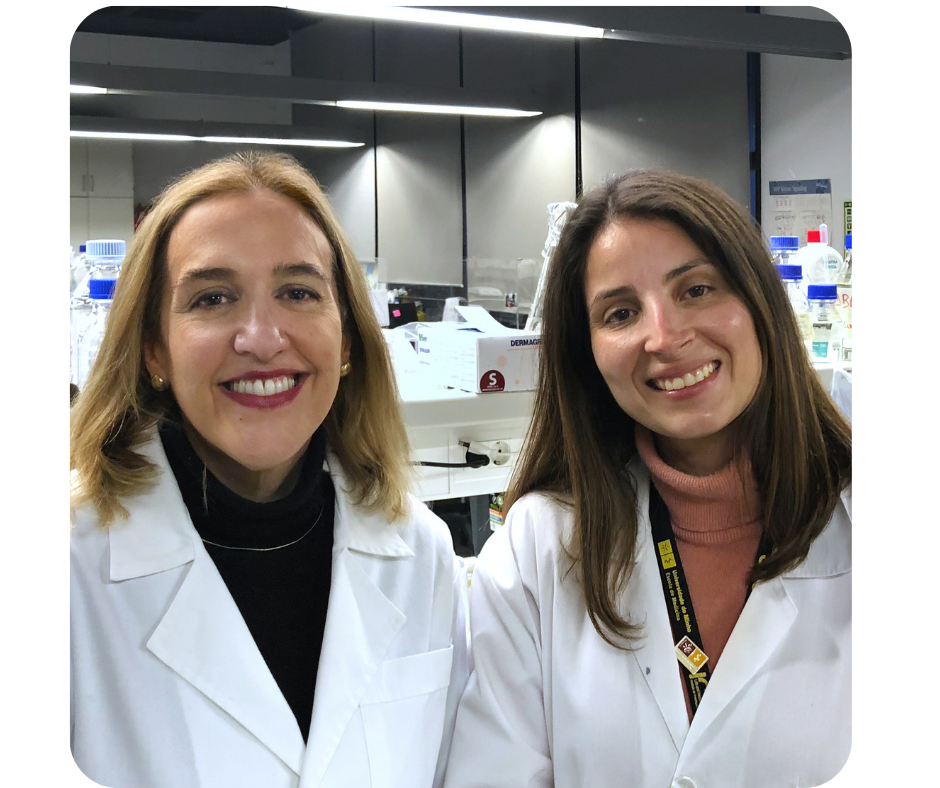We’re excited to announce that NAF will award more than $850,000 in Ataxia research grants this year! This year’s funded projects will support research on 8+ genetic forms of Ataxia, from the most common to some of the rarest, as well as address shared disease pathways that could provide insights into ALL of the Ataxias. These grants allow Ataxia investigators to request funding for their studies to lead us closer to possible treatments.
"I am so impressed by this year’s awarded grants and look forward to seeing how much further these outstanding scientists can push us towards our shared mission of a world without Ataxia. I have seen firsthand how NAF research grants can jumpstart the discovery of new treatments for the Ataxias. As a PhD student I worked on a research project supported by a 2014 NAF research grant. Today there is an active phase I clinical trial testing a potential drug that can be directly traced back to that funded work. Every dollar that goes into Ataxia research counts, and we at NAF thank all our members for their generous contributions and support."
Lauren Moore, PhD
NAF Chief Scientific Officer

Ataxia impacts every aspect of a person’s life – and we need solutions. Research and drug development will provide those solutions. NAF approved funding for 16 out of 86 Ataxia research grants reviewed in 2022. A full list of the research studies and their lay summaries are available below.
Lay Summaries
Research Seed Money Grants

Claudio Marcelo Aldez, MD, PhD
University of Texas M.D. Anderson Cancer Center (Houston, TX)
Role of WWOX loss-of-function in progressive cerebellar ataxia
Ataxia Type: Cerebellar Ataxias
Germline loss-of-function (LoF) mutations affecting the gene WWOX are causally linked to multiple neurodevelopmental disorders including autosomal recessive spinocerebellar ataxia type 12 (SCAR12) and developmental and epileptic encephalopathy 28 (DEE28). Importantly, WWOX has also been identified as a risk gene for common neurodegenerative disorders such as Parkinson’s disease and Alzheimer’s disease. Thus, the spectrum of central nervous system (CNS) disorders associated with WWOX is broad and heterogeneous, and there is little understanding of potential mechanisms at play. Given that several ataxia-related CNS disorders are associated with WWOX, it is important that we investigate its role to gain deeper insight into pathogenic mechanisms.
We hypothesize that WWOX function deficiency leads to alterations in neuronal differentiation and function while also enhancing neuroimmune activation. In this project using a recently developed SCAR12 mouse model, we will characterize the cellular and structural abnormalities cause in brain by a SCAR12 WWOX (P47T) LoF mutation. We will also investigate the effects of such mutation at the transcriptomic and proteomic levels. This information will allow us to build molecular networks relevant to WWOX LoF in ataxia pathogenesis.
Understanding the intriguing role of WWOX LoF in conditions associated with ataxia and neurodegeneration has the potential of leading to novel rationale based therapeutic interventions.

Jennifer Faber, MD
German Center for Neurodegenerative Diseases (Bonn, Germany)
Disease evolution of SCA3: A data-driven approach
Ataxia Type: SCA3
For any clinical trial, precise knowledge of the evolution of clinical impairment and biomarkers is a mandatory requirement. It is our goal to develop a data-driven model of the disease evolution of Spinocerebellar ataxia type 3 (SCA3) that is based on large datasets from different cohorts and includes not only clinical information but also information on blood and imaging biomarkers. With this project, we want to make the enormous potential of data science usable for SCA3. biomarkers, such as blood levels and imaging parameters.

Matthias Christof Truttman, PhD
The Regents of the University of Michigan
(Ann Arbor, MI)
Determining the role of FICD in mitigating mATXN3 toxicity
Ataxia Type: SCA3
Spinocerebellar Ataxia 3 (SCA3) is caused by changes in the gene ataxin-3, which lead to the production of a faulty Ataxin-3 protein. This faulty protein tends to form big protein clumps, which are often problematic for cells and kill them. With support from NAF, we will study how another protein, called FICD, regulates faulty Ataxin-3 clumping in brain cells. We believe that changing FICD activity may offer a new strategy to help brain cells survive faulty Ataxin-3 production.

Matthew Scaglione, PhD
Duke University School of Medicine
(Durham, NC)
Mechanisms of Neurodegeneration in SCA48
Ataxia Type: SCA48
Spinocerebellar ataxia 48 (SCA48) is the most recently identified form of spinocerebellar ataxia and has been suggested to be a more common cause of ataxia. Currently little is known about the mechanisms that cause SCA48. To fill this knowledge gap we will investigate the mechanisms that cause SCA48 both in cells and in vivo.

Marija Cvetanovic, PhD
Regents of the University of Minnesota
(Minneapolis, MN)
Co-funded with BAARC
Molecular mechanisms and consequences of Purkinje cell vulnerability in SCA1
Ataxia Type: SCA1
Purkinje cells (PCs) of the cerebellum are among the most vulnerable cells in spinocerebellar ataxia type 1 (SCA1). PCs play an important role in the cerebellum, and their dysfunction can contribute to ataxia experienced by patients with SCA1. This proposal will find out how the function of PCs is altered in a mouse model of SCA1 during rest, walking, and running.

Matthew Burns, MD, PhD
University of Florida (Gainesville, FL)
Asessment of diffusion imaging metrics in progression of SCA1 & 3
Ataxia Types: SCA1 and SCA3
Spinocerebellar ataxias (SCAs) are a group of diseases caused by mutations in specific genes which result in progressive balance, speech, and coordination problems which can significantly affect quality of life and lead to early death. Despite advances in potentially meaningful therapies for SCAs, accurate measurement of disease progression is essential to assess the effects of these therapies. Promising preliminary data suggests that advanced MRI imaging could accurately measure disease progression. Our proposal will use the READISCA imaging dataset to test if diffusion MRI is a sensitive and specific non-invasive measure of disease progression and a key tool in therapeutic discovery.

James Orengo, MD, PhD
Baylor College of Medicine (Houston, TX)
Investigating motor neuron degeneration in Spinocerebellar Ataxia type 1
Ataxia Type: SCA1
Spinocerebellar ataxia type 1 (SCA1) is a progressive neurodegenerative disease, whereby individuals gradually develop incoordination, which progresses to being weak, short of breath, and culminating in premature death. Our work aims to understand which brain cells are responsible for the premature death and what changes within them lead up to their degeneration. Understanding these details are important for developing effective treatments for patients with SCA1.
Young Investigator Awards

Vrutangkumar V Shah, PhD
Oregon Health & Science University
(Portland, OR)
The Score for Integrated Balance for Ataxia (SIBA): A Digital Balance and Gait Performance Outcome (PerfO) Score for Spinocerebellar Ataxia using Multi-Criterion Decision Analysis (MDA) Approach
Ataxia Type: Spinocerebellar Ataxias
Many rare neurological diseases that affect balance and gait, like degenerative spinocerebellar ataxia currently have no established treatment but now have exciting, novel drugs appearing in the therapeutic pipeline. However, these clinical trials are hampered by clinical scale outcomes that have inadequate effect sizes for the size of the population with the disease. We have previously demonstrated how quantitative assessment of the severity of ataxia-specific balance and gait impairments from wearable technology could provide sensitive performance outcome measures with high face validity to power clinical trials. The aim of this study is to provide a novel approach to developing a digital composite balance and gait score for spinocerebellar ataxia. We will investigate the clinimetric properties of the proposed composite score to test its validity and reliability.

Ian Harding, PhD
Monash University
(Clayton, Australia)
Remote Assessment of Cognition, Mood, Speech, and Movement in Spinocerebellar Ataxias
Ataxia Types: SCA2, SCA3, SCA6
Current clinical management focuses largely on movement deficits in people with spinocerebellar ataxias (SCAs), despite growing evidence that cognitive and mood symptoms also have a tremendous impact on their quality of life. Moreover, research to-date has focused primarily on the slowly evolving symptom changes that result from neurodegeneration, whereas the cause and extent of short-term (ie., day-to-day) fluctuations in disease severity is poorly understood. In this project, participants will use web-based tools to complete monthly tasks and surveys that measure movement deficits, cognitives changes, and mood symptoms. By establishing a richer characterisation of the breadth and variability of disease expression, this work has the potential to inform improved patient care and clinical trial design, while validating new symptom monitoring tools for use in clinical and research contexts.

Timothy Balmer, PhD
Arizona Board of Regents for and on behalf of Arizona State University
(Tempe, AZ)
The role of unipolar brush cell activity in cerebellar ataxia
Study Type: Neurophysiology of the cerebellum
Ataxia can be the result of disordered electrical activity of brain cells in the cerebellum, a part of the brain essential for coordinated movements. The funded work will examine the role of a poorly understood cell-type, the unipolar brush cell, in cerebellar function and its possible role in ataxia.

Roderick Maas, MD
Stichting Radboud University Medical Center
(Nijmegen, Netherlands)
Predicting treatment response to cerebellar transcranial direct current stimulation in SCA3: towards a personalized approach using state-of-the-art electric field modeling
Ataxia Type: SCA3
The administration of weak electric currents to the cerebellum through a pair of rubber electrodes has recently been shown to decrease ataxia severity in a group of patients with different causes of ataxia and might therefore represent a promising, non-invasive treatment strategy. In a just completed clinical trial in individuals with spinocerebellar ataxia type 3 (SCA3), we found that this so-called cerebellar transcranial direct current stimulation (ctDCS) unfortunately is not a “one size fits all therapy”. A critical but currently unanswered question remains to what extent ctDCS targets different cerebellar regions in patients with various degrees of cerebellar shrinkage, and consequently, which patients could potentially benefit from ctDCS and which patients may need alternative treatment protocols. In this study, we will use MRI data and state-of-the-art individualized computer simulations to determine the strength and distribution of ctDCS-induced electric fields inside the cerebellum of SCA3 patients and matched controls without SCA3, which will provide important new insights for optimizing treatment efficacy of ctDCS and may lead to the development of personalized treatment protocols.
Pre-Doctoral Fellowship to Promote Diversity in Ataxia Research

Anna Umano
Duke University School of Medicine
(Durham, NC)
Elucidating the molecular pathogenesis of Spinocerebellar Ataxia type 48 caused by mutations in the E3 ligase CHIP
Ataxia Type: SCA48
Spinocerebellar Ataxia type 48 is a debilitating neurodegenerative disease caused by mutations in the STUB1 gene that encodes for the protein C-terminus of Hsc70 Interacting Protein (CHIP). For my thesis work I will investigate how these mutations alter CHIP function and cause SCA48. Findings from this work will provide insight into how CHIP function is altered in SCA48 and may provide insight into developing therapeutics to treat SCA48.
Post-Doctoral Fellowship

Liangguang Lin, PhD
The Regents of the University of Michigan
(Ann Arbor, MI)
The novel role of SEL1L in cerebellar ataxia
Ataxia Type: Cerebellar Ataxias
Cerebellar ataxia is associated closely with the toxic proteins’ accumulation. We identified a novel mutation in the gene for SEL1L that inhibits the process by which toxic proteins are cleared and leads to the early onset cerebellar ataxia. Establishing the precise role of SEL1L in cerebellar ataxia may reveal underlying mechanism for future therapeutic treatment.

Maimuna Paul, PhD
Baylor College of Medicine (Houston, TX)
Molecular and cellular mechanisms in EBF3-related cerebellar ataxias and neurodevelopmental disorders
Ataxia Type: Cerebellar Ataxias
EBF3-related HADDS (Hypotonia, Ataxia, and Delayed Development Syndrome) is a condition in which individuals exhibit cerebellar ataxia, motor incoordination, autistic features, and variable intellectual disabilities due to damaging gene changes in the COE-transcription factor Early B-cell Factor 3 (EBF3). The proposed project implements cross-species approaches in fruit flies and mice to provide insights into the consequences of EBF3 dysfunction that are not yet explored in syndromic cerebellar ataxias. These approaches will advance the identification of critical EBF3-dependent molecular pathways in developing and mature cerebellar circuits.

Xiaojing Sui, PhD
Northwestern University (Evanston, IL)
Comprehensive identification of the metastable subproteome dysregulated in polyglutamine spinocerebellar ataxias
Study Type: The general molecular mechanisms of multiple polyglutamine Spinocerebellar Ataxias
My goal is to identify the proteins that go awry in SCAs. These proteins might serve as biomarkers to monitor the disease progression and test therapeutic approaches to suppress SCAs. To achieve these, I work at the intersection of SCAs, proteomics and big data.
Pioneer SCA3/MJD Translational Research Award

Monica Banez Coronel, PhD
University of Florida (Gainesville, FL)
RAN proteins as disease biomarkers in SCA3
Ataxia Type: SCA3
The SCA3 expansion mutation produces two mutant RNAs and unexpected toxic proteins that accumulate in disease-affected brain regions. We will use cerebrospinal fluid and blood from SCA3 patients and mouse models to test if these proteins can be used as reliable biomarkers to predict disease progression and to test the effects of SCA3 therapies.

Patrícia Maciel, PhD
Life and Health Sciences Research Institute (ICVS) and ICVS/3B’s – PT Government Associate Laboratory, University of Minho
(Braga, Portugal)
Dissecting the mechanisms of action of TUDCA as a therapeutic for SCA3
Ataxia Type: SCA3
This project aims to validate the potential of a natural compound, named TUDCA (for tauroursodeoxycholic acid), as a therapeutic agent for SCA3/MJD. This compound has shown promise in a worm model and a mouse model of the disease, but will now be tested in a second mouse model, to confirm the robustness of its effects and assess whether it is indeed an interesting candidate for studies in patients. In addition, the mechanism of action of TUDCA will be dissected using advanced molecular and cellular tools, and possible biomarkers of its action, that can be used to support clinical trials, will be explored.
Thank You Donors!
The generosity of our donors allows NAF to focus on our mission to accelerate the development of treatments and a cure while working to improve the lives of those living with Ataxia. We could not offer this service to the Ataxia research community without you!









